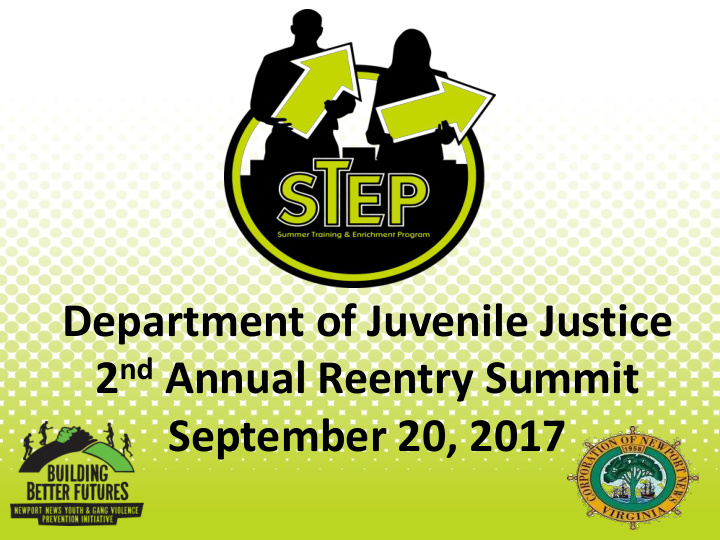



Department of Juvenile Justice 2 nd Annual Reentry Summit September 20, 2017
Overview • The Summer Training and Enrichment Program (STEP) was established in 2014 as one component of Building Better Futures, the City’s Youth and Gang Violence Prevention Initiative, which is one of the five strategic priorities of Newport News City Council • Established to provide work training opportunities to youth and young adults • STEP is funded solely through local general fund dollars
Purpose To prepare the youth and young adults between the ages of 16 to 24, who reside in the City of Newport News, for the world of work and to provide a meaningful workforce experience.
STEP Overview Program Component FY15 FY16 FY17 Planning Preparation February 2015 December 2015 December 2016 Program Duration 10 weeks 10 weeks 10 weeks Application Period April - May February - March February - April Application Process Paper Electronic Electronic Principal Partners 5 2 2 Program Participants 316 500 435 South of Mercury Blvd. and South of Mercury generally along Warwick Blvd, Service Area All residents Blvd. from Menchville Rd. to Ft. Eustis Blvd. STEP Coaches 15 30 30 Participant Interviews None Two Multiple Worksite Recruitment April 2015 February 2016 March 2017 June 19 for out of school and July Worksite Start Date Same date for all Staggered start dates 5 for in-school Participant Work Week 4 days 5 days 5 days 1 3-day session for 1 3- day session for out-of-school 1 5-day session for out of school Participant Orientation and 1 8-day session for in-school and 1 7-day session for in-school all 2 scheduled Supervisor Orientation 2 scheduled sessions 3 scheduled sessions sessions
Schedule Out of School Participants • Orientation: June 5-9, 2017 • Worksite Report: June 19, 2017 In School Participants • Orientation: June 19-27, 2017 • Worksite Report: July 5, 2017 Last Day of Work for Everyone • August 23, 2017 Closing Celebration • August 24, 2017 - Marriott at City Center
Program Accountability (2015 ● 2016 ● 2017 Target) Program Efficiency and Effectiveness Measures 1. Retention Rate – 80% ● 71% ● 80% 2. Worksite Return Rate – N/A ● 81.3% ● 85% 3. Ratio of Public/Nonprofit/Private worksites – N/A ● 41% / 17% / 41% ● 26% / 33% / 41% Self-Sufficiency & Economic Development Outcomes 1. Percent of participants receiving their first paycheck – 64% 2. Percent of participants with their first bank account – 32.9% 3. Overall number of participants offered employment – 19 ● 14 ● 20 Public Safety Outcomes 1. Participant re-offenses over summer – 1 ● 0 ● 0 2. Decline in Juvenile arrests over summer – 9% ● 27% ● 20%
Participant Development
Youth Development What is Youth Development? • An approach to working with young people that defines goals (outcomes) based on capacities, strengths, and developmental needs of youth
Resilience Common set of characteristics that predispose children to positive outcomes in the face of adversity • The availability of at least one stable, caring, and supportive relationship between a child and an adult caregiver. • A sense of mastery over life circumstances. • Strong executive function and self-regulation skills.
Implementation • Job coach, facilitator, AmeriCorps member • Resume building, goal-setting, peer-to-peer influence, field trips, growth mindset • Mindfulness • Norms, exploration of higher self
Program Operations
Job Coach Responsibilities • Ensure participant compliance • Provide supervision and guidance to participants • Conduct worksite visits • Mediate participant/worksite conflicts • Monitor goals to ensure the participant is engaged in a meaningful experience • Be prepared and engaged
Worksite Locations STEP joins City government, the business and non-profit communities, and faith-based organizations together to provide youth and young adults ages 16-24 a rewarding experience as they are introduced to the workforce. Participants gain experience through hands on participation at their site placements and enrichment activities that expose them to different career options Worksite Locations 71 Worksite Partners Public – 17 Locations For-Profit Locations – 25 Locations Not-For-Profit – 29 Locations
Worksite Relationships • Connections with local business are facilitated • Expectations are clear • Formal agreements are established • Guidance and support are provided
Worksite Locations (cont.)
Worksite Responsibilities • Reinforce work schedules and expectations • Assign participant duties and responsibilities • Monitor goals and learning objectives to ensure each participant is mastering agreed upon skills Communicate with assigned Job Coach • Mentor participants
Overall Program Outcomes • Served approx. 1400 youth and young adults • Partnered with over 75 partners (City, Public Schools, Private Sector, Non-Profit, Faith-Based) • Approximately 60 participants have been offered employment • Access to trade training through partnership with local community college and regional education center • One new criminal charge during program • 27% reduction in juvenile arrests during program
Overall Program Outcomes • Awarded the Virginia Municipal League’s Public Safety Award in October 2016 • Awarded the Peninsula Council for Workforce Development’s Workforce Excellence Award for Talent Development in September 2016 • Received Joint Resolution from Virginia’s General Assembly for efforts to reduce crime participation and exposure to different career options in September 2017
Partnerships • Buy-in • Win-win • Right people at the table • Clear roles and responsibilities • MOU/MOA • Training and preparation of staff and partners
Partners • City of Newport News • Alternatives, Inc. • Peninsula Council for Workforce Development • Newport News Public Schools
STEP Participants
STEP Participants
STEP In Action • 2017 STEP Video
Contact Information MaRhonda Echols, Program Manager Building Better Futures, City of Newport News Newport News, Virginia mechols@nnva.gov step.nnva.gov
Recommend
More recommend